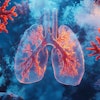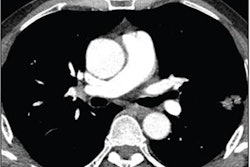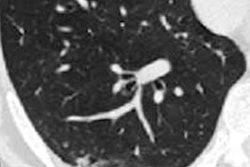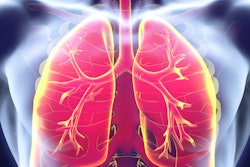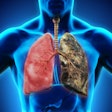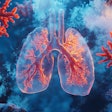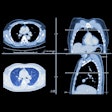Surveillance of ground-glass nodules (GGNs) found on CT appears may be appropriate until a solid component manifests, researchers have reported.
A team led by Mengwen Liu, MD, of the Chinese Academy of Medical Sciences in Beijing found no significant differences in long-term survival in individuals with ground-glass nodules who were either tracked by CT surveillance or underwent surgery -- and no significant differences between stable and increased nodule size during follow-up. The group's results were published on October 7 in Radiology.
"[Our] results suggest that both surveillance and surgery groups demonstrate comparable favorable oncologic outcomes, and the cost and duration of surgery are similar for stable GGNs and GGNs that increased in size," the team wrote.
Whether to manage lung ground-glass nodules that enlarge over the course of follow-up with continued surveillance or with surgery remains under debate, the authors wrote.
"The inconsistency in ground glass nodule management strategies makes it challenging to handle GGNs in clinical practice, especially those that increased in size during surveillance, leaving concerns about the necessity of surgery and safety of surveillance unresolved," the authors wrote.
They sought to address the issue with a study that included 1,003 ground-glass nodules found on CT imaging between March 2005 and December 2013 in 684 individuals (median age, 56). The team tracked study participants through May 2024. Among these 684 people, 40 had nodules that developed solid components, while 644 maintained ground-glass nodule status; of the 684, 228 underwent surgery and 456 were surveilled.
The group's primary analysis was a comparison of overall survival between those patients who were surveilled and those who underwent surgery among subsets of individuals with ground-glass nodules, stable ground-glass nodules, and ground-glass nodules that increased in size. As a secondary outcome of the study, the team tracked patients' recurrence-free survival and analyzed the cost and duration of surgery.
Liu and colleagues reported the following:
- No difference in 10-year overall survival between surveillance and surgery groups (94.7% vs. 97.6% [p = 0.1]).
- No evidence of association between surgery and 10-year overall survival in those with ground-glass nodules (hazard ratio, 0.56 [p = 0.33]) after multivariable adjustment, and no evidence of this association between those with ground-glass nodules that increased in size and those with stable nodules (hazard ratio, 0.78 [p = 0.78] and 0.29 [p = 0.3], respectively).
- There was no difference in seven-year recurrence-free survival among 31 people with stable ground-glass nodules and 48 with ground-glass nodules that increased in size (100% vs. 100% [p > 0.99]).
- The group found no evidence that increased ground-glass nodule size influenced the cost of surgery ($8,401 vs. $8,388 [p = 0.79]) or its duration (2 hours for both [p > 0.99]).
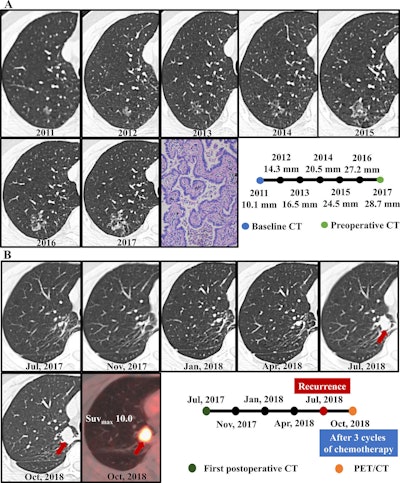 Progression of ground-glass nodule (GGN) imaging from initial detection through surgery to recurrence in a 57-year-old man. The contrast-enhanced axial chest CT scan obtained in August 2011 demonstrated a GGN in the right upper lobe. After 7 years of CT surveillance, wedge resection was performed in April 2017. The postoperative pathologic examination showed well-differentiated adenocarcinoma with a pathologic stage of T1a. Routine surveillance after surgery revealed local recurrence in July 2018. Chemotherapy and immunotherapy were performed, and the individual was alive at the last surveillance in 2024. (A) Consecutive CT scans obtained from 2011 to 2017 show May the growth history of the GGN during active surveillance. The average diameter of the nodule increased from 10.1 mm in 2011 to 28.7 mm in 2017. Photomicrograph obtained at pathologic analysis confirms the diagnosis of lung papillary adenocarcinoma (hematoxylin-eosin stain; original magnification, ×200). (B) Regular 3-month postoperative CT scans display the individual’s progression since surgery in April 2017. A soft tissue nodule in the surgical area was detected in July 2018, which led to a diagnosis of postoperative recurrence (arrows). The individual subsequently began chemotherapy, and in October 2018, a PET/CT scan was obtained to evaluate the effectiveness of the chemotherapy treatment. Suvmax = maximum standardized uptake value. Images and caption courtesy of the RSNA.
Progression of ground-glass nodule (GGN) imaging from initial detection through surgery to recurrence in a 57-year-old man. The contrast-enhanced axial chest CT scan obtained in August 2011 demonstrated a GGN in the right upper lobe. After 7 years of CT surveillance, wedge resection was performed in April 2017. The postoperative pathologic examination showed well-differentiated adenocarcinoma with a pathologic stage of T1a. Routine surveillance after surgery revealed local recurrence in July 2018. Chemotherapy and immunotherapy were performed, and the individual was alive at the last surveillance in 2024. (A) Consecutive CT scans obtained from 2011 to 2017 show May the growth history of the GGN during active surveillance. The average diameter of the nodule increased from 10.1 mm in 2011 to 28.7 mm in 2017. Photomicrograph obtained at pathologic analysis confirms the diagnosis of lung papillary adenocarcinoma (hematoxylin-eosin stain; original magnification, ×200). (B) Regular 3-month postoperative CT scans display the individual’s progression since surgery in April 2017. A soft tissue nodule in the surgical area was detected in July 2018, which led to a diagnosis of postoperative recurrence (arrows). The individual subsequently began chemotherapy, and in October 2018, a PET/CT scan was obtained to evaluate the effectiveness of the chemotherapy treatment. Suvmax = maximum standardized uptake value. Images and caption courtesy of the RSNA.
"Our study provides valuable insights into the management of GGNs by comparing outcomes between surveillance and surgery groups and assessing the cost and duration of surgery at different surgical time points and on GGNs with different growth patterns," the team wrote. "Moving forward, we plan to integrate preoperative surveillance costs with surgical costs to optimize subsolid nodule management."
The research results "confirm the indolent nature of GGNs and suggest that surveillance alone for GGNs is a safe management strategy," wrote Mark Hammer, MD, of Brigham and Women's Hospital in Boston, in an accompanying editorial.
"The findings also suggest that resection as the standard treatment for all GGNs likely represents overtreatment," Hammer noted. "Thus, radiologists will continue to play a critical role in the management of GGNs."
The complete study can be found here.




